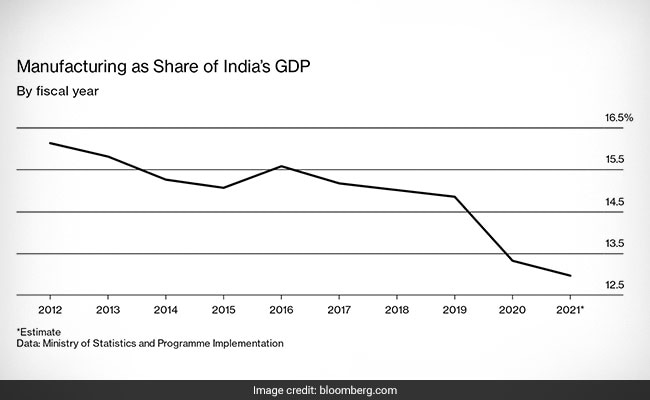
India's budget went paperless for the first time this year. That's because the pandemic rendered unsafe the traditional practice of locking away dozens of Finance Ministry staff inside a government printing plant to ensure none of the blueprint's secrets spilled out. Instead, Finance Minister Nirmala Sitharaman presented the spending plan to Parliament reading from a Samsung electronic tablet, which the media took pains to identify as "Made in India."
"Our manufacturing companies need to become an integral part of global supply chains, possess core competence and cutting-edge technology," said Ms Sitharaman in her February 1 address. Tucked into the government's spending plan for the coming fiscal year, which starts on April 1, is a $28 billion program to persuade foreign manufacturers to set up operations in India. It offers cash incentives for meeting certain sales targets in industries including autos, electronics, and pharmaceuticals, aimed at luring investors from regional rivals such as China and Vietnam that have lower operating costs.
Part of Prime Minister Narendra Modi's "Self-Reliant India" drive, the program is expected to boost output by $520 billion over five years, according to official projections. Credit Suisse sees it adding 1.7% to gross domestic product by 2027, while creating 2.8 million jobs.

Photo Credit: Bloomberg
It's tempting to see Self-Reliant India as a repackaged version of ambitions outlined repeatedly over past decades. The most recent was Modi's "Make in India" campaign. Unveiled in 2014, it aimed to bump up manufacturing's contribution to GDP from 15% to 25% over five years. Instead, the share fell and now languishes at around 13%.
This time around there are some early signs of success. Amazon.com Inc. unveiled plans in February to set up a manufacturing line in Chennai to produce Fire TV streaming devices in partnership with an Indian subsidiary of Taiwanese electronics giant Foxconn Technology Group. And Apple said this month it will begin producing the iPhone 12 in India for local customers. "The relocating to India trend has already started to gain momentum," says Tanvee Gupta Jain, a Mumbai-based economist at UBS Securities. "This is a significant turn in India's manufacturing policy."
The Modi administration is courting other big-name foreign manufacturers, including Tesla Inc., which filed paperwork in January to register a business in India, fanning speculation that it plans to open a production line there. While the company hasn't commented on the rumors, Transport Minister Nitin Gadkari has said the government is prepared to offer incentives to ensure that Tesla's cost of making electric vehicles in India would be less than in China.
In late February, PM Modi-led cabinet approved earmarking $1 billion of the larger incentives package for a program geared at expanding domestic production of tablets, laptops, and computers, which hasn't kept up with surging demand. Imports of laptops alone, mostly from China, have soared 42% in the past five years and are estimated to have reached almost $5 billion in the current fiscal year, according to a report commissioned by the India Cellular & Electronics Association. Under the new rules, companies will be eligible for cash payments equal to as much as 6% of the value of their sales, depending on how much they increase domestic production.
The story in India has long been that for every optimistic new entrant, there's a battle-scarred business looking for the door. Harley Davidson Inc. pulled out of India late last year, while Toyota Motor Corp. in September threatened to shelve expansion plans because of the high taxes India levies on new-vehicle purchases. What sends foreign companies fleeing is a combination of entrenched protectionist tendencies, complex regulations, and rickety infrastructure. India ranked 63rd among the 190 countries the World Bank surveyed in its latest Doing Business report. China came in at No. 31, and South Korea was No. 5. "The real problem in India is the unease of doing business," says Pranjul Bhandari, HSBC Holdings Plc.'s chief India economist.

Around the world, pandemic-induced shortages and supply chain disruptions have brought new urgency to government-led efforts to achieve greater self-sufficiency, whether in ventilators or semiconductors. China's latest five-year plan contemplates large increases in investment in areas such as integrated circuits and clean tech, while in the US, the Biden administration has urged Congress to appropriate funds for subsidies to spur the construction of new US fabs.
India's efforts to nurture domestic supply chains have historically relied heavily on import tariffs, which are still the highest of any major economy in Asia. By adding investment incentives to its arsenal, the government hopes to persuade more multinationals to open plants in the country. If the policy mix seems incongruous, it's because in today's India, economic priorities are often at odds with political realities. PM Modi must boost manufacturing to create the 10 million new jobs a year the country needs to accommodate its growing workforce as well as curb yawning trade deficits, especially with China. But he also has to cater to the small and midsize enterprises that make up his ruling Bharatiya Janata Party's base, and they've become accustomed to being shielded from foreign competition.
This clash makes it tough to tell whether Self-Reliant India will succeed where initiatives of years past failed. India is the world's second-most populous country, which should be incentive enough for foreign businesses. PM Modi's sweeteners may compel more of them to take the plunge.
Track Latest News Live on NDTV.com and get news updates from India and around the world

